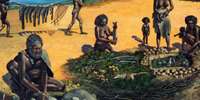Back to Don's Maps
 Back to Australian sites
Back to Australian sitesNaracoorte Caves
Found: A pocket guide to prehistoric Spain * 05 August 2009 by Charles Choi and Catherine Brahic * Magazine issue 2720. Subscribe and get 4 free issues. * For similar stories, visit the Human Evolution Topic Guide MODERN humans have got it easy. Anyone with a computer can look up just about any location and within seconds bring up a map complete with step-by-step directions from A to B. The internet and centuries of map-making mean getting to, say, the prehistoric painted caves of France and Spain is child's play. "But imagine a group of hunter-gatherers, returning to an area they had not been to for a long time. How do you find a particular cave, especially if the vegetation has changed and its entrance may be masked?" asks independent archaeologist Paul Bahn. The answer may be that hunter-gatherers had their own maps. A team of archaeologists have matched etchings made 14,000 years ago on a polished chunk of sandstone in northern Spain to the landscape in which it was found. They claim to have the earliest known map of a region in western Europe - a prehistoric hunting map. The rock, roughly hand-sized and 14,000 years old, bears a mess of overlapping etchings. It was found in a cave in Navarre on the southern side of the Pyrenees and it took Pilar Utrilla of the University of Zaragoza, Spain, and colleagues the better part of 10 years to disentangle the lines and make sense of them (Journal of Human Evolution, DOI: 10.1016/j.jhevol.2009.05.005). Above recognisable depictions of reindeer, a stag and some ibex are what Utrilla's team believe is a representation of the landscape surrounding the cave. Several etched lines resemble the shapes of mountains that are visible from the cave. Long, meandering etches match the course of a river that runs at the foot of one of the mountains and splits into two tributaries. A series of strokes that cut across the river near the mountain could represent places where it was easily crossed, or even bridges, the researchers say. See a picture of the etchings "This is a pretty spectacular find," says prehistoric archaeologist Lawrence Straus of the University of New Mexico in Albuquerque. "It may give us a glimpse into the ways in which people navigated and explained their territories." He says the slab was etched during a period of enormous cultural activity in northern Spain. "The human range was expanding northward and population density was increasing after people nearly died off in the last glacial maximum about 20,000 to 17,000 years ago. People were perhaps having to cooperate, carving up territories among different bands. They had to live by their wits and what the landscape provided." Strauss says engravings and paintings would have helped with territorial definition, hunting, human aggregation and mobility, and generally making sense of the world. This spectacular find may give a glimpse into the way people navigated and explained their territories "The interpretation is, of course, pure speculation, as with all other such claims for Ice Age maps," says Bahn. "On the other hand, it would be extremely surprising if these people did not produce rough maps. They were as intelligent as we are and were constantly moving around the landscape." He agrees the stone is the best bet for a prehistoric western European map so far. Others take issue with this interpretation. According to Jill Cook, head of the prehistory division at the British Museum in London, hundreds of similar etchings have been found sprinkled across Europe. "Multiple lines positioned over animal figures is not unusual in slabs of this period. We haven't traditionally considered them to be maps." She also doesn't believe humans at the time had any need for maps (see next week's issue of New Scientist). "Their intimacy and knowledge of the landscape, including the location of individual trees and plants, would be such that maps would be less vital to them. On the whole, art of this period doesn't include landscape elements - no trees, rivers or hills - so this interpretation is very brave," she told New Scientist. Archaeologist Jean Clottes, an expert for the International Council on Monuments and Sites, agrees that prehistoric humans probably had excellent mental maps to help them navigate. He has an alternative explanation for the engravings. Clottes believes that instead of connecting the artist to the physical world, they may have acted as a bridge to another, spiritual world. "For these people, their landscape was likely sacred. A map might not have helped them go from one place to another, but instead could have marked the places of very significant sacred places." Maps through the millennia There's no doubt our ancestors relied on maps. Here are some of the oldest known examples. * The oldest map found in Europe, discovered in Pavlov in the Czech Republic, is about 25,000 years old. It depicts a mountain, river, valleys and routes around the region. * A schematic 6200-year-old drawing of Çatalhöyük in Turkey may be the oldest known city map. * The oldest known map of the world dates to 600 BC. It is inscribed on a clay tablet discovered in the city of Sippar in southern Iraq, is centred around Babylon and shows the world as a circle surrounded by "bitter water": the salty sea. * The oldest complete star atlas, measuring 2 metres across, was discovered in China in 1907. It dates from the 7th century AD and marks the position of 1339 stars, including clearly recognisable groups such as Orion and the big dipper.